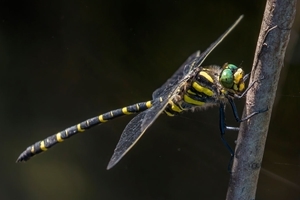Golden-ringed dragonfly
A voracious predator, that even other dragonflies are not safe from, the golden-ringed dragonfly is the UK’s longest species
 On a recent trip to the New Forest with colleagues to undertake a day of river and stream metric assessment training, I watched a mighty dragonfly quartering where we sat at lunch on the riverbank, hunting its prey, only to get a better look at her as she was still for a fleeting moment to stab her abdomen into the streambed – laying her eggs. It was a golden-ringed dragonfly (Cordulegaster boltonii).
On a recent trip to the New Forest with colleagues to undertake a day of river and stream metric assessment training, I watched a mighty dragonfly quartering where we sat at lunch on the riverbank, hunting its prey, only to get a better look at her as she was still for a fleeting moment to stab her abdomen into the streambed – laying her eggs. It was a golden-ringed dragonfly (Cordulegaster boltonii).
The golden-ringed dragonfly is a very large, striking dragonfly, on the wing from May to September, and the female is the UK's longest dragonfly (because of her long ovipositor). It is a dragonfly of small, acidic streams in moorland and heathland, found in west Scotland, Cumbria, southern England and Wales, and may be seen away from its breeding sites hunting across the heather and surrounding habitats. Golden-ringed dragonfly are fast, agile and powerful flyers, which aids them well as a voracious predator, feeding on large insects, such as damselflies, wasps, beetles, bumblebees and other dragonflies.
As the name denotes, the golden-ringed dragonfly has bright yellow-gold bands along an otherwise black body, looking like huge, thin wasps with bright green eyes. Both male and female have the same colouring but display subtle differences to enable identifying which sex it is. Females are longer and thinner than the males and display a ‘waisted’ appearance.
Dragonflies have an interesting life cycle, starting with the egg. Adult females lay hundreds of eggs in batches over a few days or even weeks, depending on the species – either endophytic (elongated in shape and laid into plant material) or exophytic eggs (round in shape, laid in a jelly-like substance and deposited loosely into water). Golden-ringed dragonflies lay endophytic eggs by hovering vertically and stabbing their abdomen into cold streambeds; this action means the eggs are less likely to be washed away by the current. The eggs hatch at different timescales depending on the species, either within 2–5 weeks or, in the case of the emerald damselflies and some hawkers and darters, the following spring.
Dragonflies spend most of their lives in their larval stage. During this time, golden-ringed dragonflies live buried at the bottom of streams, ambushing prey as it passes by at every opportunity, moulting a further 5-14 times until fully grown. Larval development typically takes one or two years, but ranges from 2–3 months (emerald damselflies) to more than five years for the golden-ringed dragonfly. This is because development takes longer in cooler waters where food is scarcer, while the species of dragonflies that lay their eggs in warmer still waters may have a new generation every year.
Dragonflies undergo incomplete metamorphosis; unlike other winged insects, such as butterflies, dragonflies transition straight from a larva to an adult. This transition, the final larval moult, takes place out of water when the larvae climb up emergent vegetation (reeds and rushes) and, finding a secure support, redistribute their body fluids, pushing the thorax, head, legs and wings out of the larval skin. There is then a pause of about 30 minutes to allow their legs to harden enough for the next stage, when the abdomen is withdrawn. The wings, and then the abdomen, are expanded and start to harden. This process leaves behind a cast skin, called an exuvia (one of my favourite words!), and the whole process lasts about three hours. As a child I used to collect the exuvia I found left clinging to bullrushes and reeds – a fascinating wild ‘treasure’ to find and something to scare a sibling with!
Megan Lock
Advisory
Image credit: Charles Sharp